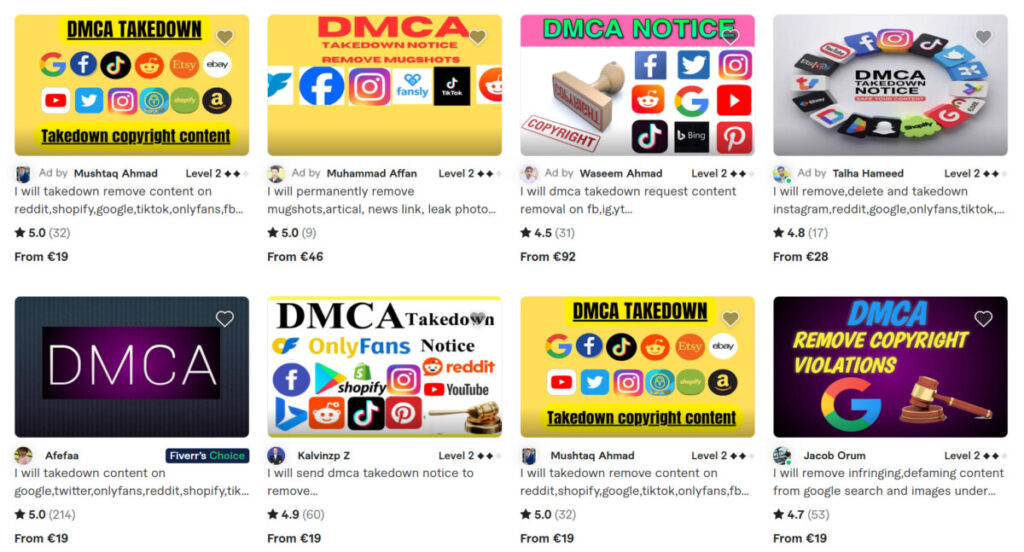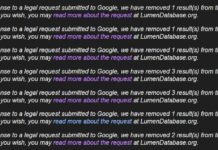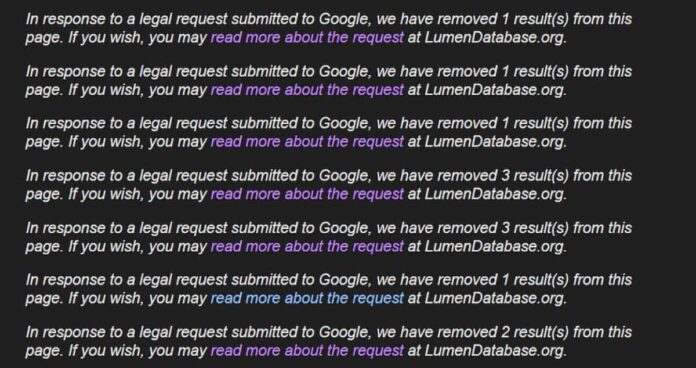Fraudulent Digital Millennium Copyright Act (DMCA) takedown requests have long plagued the mainstream news and e-commerce sectors, but they have also emerged as a significant threat to the affiliate industry.
DMCA began as a shield for copyright holders but has been abused by bad actors to censor competitors and manipulate search rankings, inflicting financial harm.
Recently, many affiliate sites have reported dozens, if not hundreds, of inaccurate notices, with Google invalidating only a small fraction of them.
Fraudulent Takedowns Could Cost Companies Millions
The impact of false Google DMCA takedowns is significant in the gambling industry, where nefarious SEO tactics are being used to harm competitors for extended periods.
This is happening across some of the most valuable keywords in the online gambling industry, and as such, millions of dollars in revenue are switching hands due to fraudulent activity.
According to one newsroom SEO we spoke to:
“It’s fairly common to see DMCA Copyright requests with completely inaccurate claims in the news, especially related to stories about wealthy or powerful figures. The requests are bogus, and often the content is in a different language from the material being taken down.”
“Much of the time, the entire takedown process is likely automated and triggered by new pages appearing in search for key people, places, and things. It’s supposed to take 14 days or so to appeal a decision, which usually has stories coming back well after they are newsworthy. I fight the most egregious ones, but that’s maybe one in 20.”
This growing threat highlights the DMCA’s vulnerabilities and underscores the criticisms that have been made of the current system.
Marketplaces Selling Takedown Services
Many freelancers offer DMCA takedown services on online marketplaces like Fiverr and Upwork. These sellers and individuals often have high ratings and satisfaction rates for these services on these platforms.
This is an unsettling development for online publishers, as it indicates their content is very much at the whim of a certain individuals: the employees at Google who process these claims and can make an article disappear before any appeal can be made.

Understanding the DMCA
The DMCA was enacted in 1998. It was designed to protect intellectual property rights online by allowing copyright holders to request the removal of infringing content.
The relevant provision of the DMCA is Section 512 (Safe Harbor), which limits online service providers’ liability for user-generated content. However, to qualify for protection, the provider must have measures in place to remove allegedly infringing material upon receipt of a valid request.
Section 512 allows copyright holders to send a written notice to a service provider requesting the removal of material they believe infringes on their copyright. As long as the request appears valid, the service provider must comply swiftly.
If the user who supplied the content believes their material was removed in error, they can submit a counter-notice. The service provider must then restore the content unless the copyright owners initiate legal action against the alleged infringer.
However, Section 512 allows the complaining party ten days to file their suit, and the material can’t be restored within that time. In effect, even a baseless takedown request will result in the material being offline for up to two weeks, which is a long time in news and the affiliate space.
DMCA’s Structural Weakness: Built for Speed, Not Fairness
According to the US Copyright Office, the DMCA was intended by Congress for copyright owners and service providers to cooperate, detect, and address copyright infringements.
However, while this “notice-and-takedown” approach reduces the liability and burdens on platforms, it prioritizes speed over accuracy.
Critics argue this approach also favors quick removals without a thorough review. That invites fraudsters to exploit loopholes by sending fake notices, overwhelming moderation systems.
The Copyright Office acknowledges the flaws in the current law. The department conducted a study on Section 512. Its findings, published in 2020, concluded the current safe-harbor framework is “unbalanced.”
The study identified several areas where the current implementation diverges from what Congress intended. Those include service-provider eligibility criteria, repeat-infringer policies, knowledge requirement standards, notice specificity, and the interplay between subpoenas and injunctions.
Based on the study’s findings, the Copyright Office does not recommend significant changes to section 512. Instead, it suggests that Congress “fine-tune” certain areas to “better balance the rights and responsibilities of online service providers and rightsholders in the creative industries.”
Evidence of Abuse
The scale of DMCA notices has grown significantly. Google’s Transparency Report shows hundreds of millions of URL removal requests annually.
YouTube’s data shows that 6% of video-related takedown requests in 2024 were filed with false assertions of copyright ownership.
Between 2019 and 2022, Lumen database logged nearly 34,000 DMCA false requests designed to remove legitimate news content. The perpetrators would use a “back-dating” tactic where they would republish the original content with a fake publication date chosen to be earlier than the original’s. They would then claim the original was infringing on their copy.
While 99% of those notices were unsuccessful, approximately 300 valid URLs were incorrectly removed. After that, the perpetrators would remove the copy, effectively erasing the information from the internet.
However, it is not just news posts being taken down. Whole affiliate pages have been taken down as a result of abuse, causing significant financial damage to businesses. Additionally, copyright claims made have zero resemblance to any content on the sites they are allegedly taken from.
In 2024, Lumen identified another 60,000 questionable notices. While their target appeared to be Turkish escort websites, the notices wrongly included URLs from local news outlets and other domains, many of which included the keyword “escort.”
Online gambling affiliates are also affected. After reaching out to multiple publishers, none would comment on the record.
However, one shared (above) with us that they had received just one response from Google to over 50 requests within a 30-day period. This was deemed invalid; the remaining 49 requests are outstanding, significantly exceeding the typical 14-to 18-day appeal window.
Gambling Industry Abuse: Government Requests and Copyright Claims
A trend identified in the gambling industry affiliate space is spurious copyright claims, and fraudulent government requests.
Copyright claims have often been found to be made by non-existent entities, such as “Peasy IP Law” and “Ridgefield IP Law”, with mismatching details.
The above example shows a fictional entity filing a complaint from Denmark, on a UK domain, on behalf of an entity based in Hong Kong.
CasinoBeats also understands that a significant portion of government requests is also fraudulent. This is evidenced by numerous instances in Germany, while the German authorities do not initiate DCMA takedowns.
Furthermore, there are numerous examples of the UK Gambling Commission initiating takedowns. The sender varies from “The Gambling Commission” to “Gambling Commission” to “UK Gambling Commission” across different requests.
The UKGC contacts offending sites, and none of the impacted webmasters contacted by CasinoBeats had received any communication from the regulator.
Case Study: Google vs. the Vietnamese Duo
In November 2023, Google filed a lawsuit against two Vietnam-based men, Nguyen Van Duc and Pham Van Thien (plus up to 20 unnamed co-conspirators), for orchestrating a massive DMCA-abuse campaign.
Google alleged that the two men weaponized the copyright law’s notice-and-takedown system to sabotage competitors’ websites from search results.
Allegedly, the perpetrators used at least 65 Gmail accounts to submit over 117,000 confirmed and almost half a million suspected fraudulent notices, targeting up to 620,000 URLs.
They claimed to represent major companies, such as Amazon and Twitter, as well as high-profile individuals, including Elon Musk and Taylor Swift. Sometimes, they also used company names that do not exist, along with addresses associated with innocent families or businesses.
Google’s complaint highlighted that one client had over 35,000 URLs removed during the critical holiday season, resulting in $5 million in lost revenue. That also cost Google $2-3 million in lost ad business.
As the defendants did not show up in court, Google moved for a default judgment (which, as of mid-2025, is pending).
If Google prevails, Nguyen and Pham could face damages under DMCA § 512(f) and other fraud claims, as well as an injunction banning them from using Google services.
Regulatory Response and Potential Solutions
Despite the growing abuse of the DMCA, regulatory and industry responses have been scarce. Google’s lawsuit against Nguyen and Pham shows that companies are beginning to find ways to fight back against those abusing the system.
Eliminalia’s case has also brought light to the issue for Spain and other EU regulators and jurisdictions. However, reform is needed to address these issues effectively.
As the US Copyright Office’s study points out, the current law does not align with the industry’s changes and fails to address the growing number of bad actors.
For the affiliate industry, increased awareness and pressure for legislative reform to close DMCA loopholes are critical. The rise of DMCA abuse poses a growing threat not only to affiliates but also to the entire digital publishing sector.













